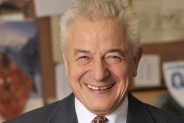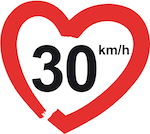Professor Dr. Hermann Knoflacher: Who can adequately react at 50 km/h?
on Apr 27, 2013

Humans were not designed to go faster than 30 km/h, says Professor Dr. Hermann Knoflacher, Professor Emeritus and Director of the Institute for Transport Planning and Traffic Engineering at the Technical University of Vienna, Austria. He agreed to support our European Citizens´ Initiative “30 km/h – making the streets liveable”. and be our first “ambassador”. In an interview he explained his reasons.
30kmh.eu: Which speed in town do you think is the most appropriate?
Knoflacher: Walking pace.
If you go any faster, you immediately have the disadvantage that you need artificial aids, such as the car, which then use much more energy. But using them doesn’t mean that you really experience or achieve more, just that you can travel further in the time.
People move best when on foot and transport planning for the future is based upon this. Of course there are exceptions for disabled people, who need their cars to travel around the city. And for deliveries too: goods that can’t be transported otherwise.
The problems begin when we make something too easy. This includes driving a car. In a car, you need half, a quarter or even just one-sixth of the energy someone walking at a slow, medium or fast pace needs, but you cover 10, 20 or 30 times the distance in that time. People tend to naturally favour the easier option and so we usually spontaneously chose to drive.
But this then involves travelling at speeds exceeding what our bodies have evolved to cope with, speeds beyond our perception. The sensory abilities of people are only optimised for walking speed.
30 kmh.eu: Let’s talk about the difference between the two speeds: 30 and 50 km/h
Knoflacher: When 50 km/h was introduced, it was a purely arbitrary decision. But there are physical, biological arguments for 30 km/h. The human body is designed so that it can reach a speed of 30 km/h when running fast: indeed the world record is around 37 to 39 kilometres. At these speeds, also in a car, we are still able to process the information our brain is receiving. This allows us to respond to unforeseen events quickly enough to avoid accidents, by swerving out of the way, for example.
But anything faster than that is asking for trouble. The current speed limit of 50 km/h or more, exceeds our evolutionary development, it goes further than our perception. We are covering distances that though they are technically possible, we cannot mentally cope with them. So the risk of accidents increases. If the authorities allow higher speeds, they cannot then blame the individual motorist. Just as you cannot make a blind man responsible for his actions if he did not see something in time – as it is impossible for him to do so.
But the Highway Code does exactly that: It demands that everyone can adequately react at 50 km/h. As I said, this is biologically impossible. This is paramount in public transport, in a closed system in which one individual has given up his or her responsibility. Public transport then needs the right environment, involving complicated external information and safety systems to ensure that people and goods can be transported safely.
But if a person can travel at 30 km/h, this is an optimal speed.
30kmh.eu: Slowing down is not necessarily the most obvious choice for a traffic scientist. How did you reach this conclusion?
Knoflacher: Early on in my career, I got the jobs that no-one else wanted. In 1968, I planned the first phase of the pedestrian zone in the centre of Vienna. The idea then was that the whole of the city centre should be car-free by the mid-1980s.
In 1973/74 I had planned all the Viennese districts to have a speed limit of 30 km/h, but this was opposed by the authorities. One of my employees even resigned in despair over this! I was accused of wanting us to return to the Stone Age.
In 1975, I was still involved in the development of a traffic concept for Vienna. I was the youngest of four professors and once again, got all the tasks the others didn’t want: public transport planning, park planning, pedestrian traffic, road safety. That gave me the chance to put my principles into the concept. I really wanted bicycles to be a part of all this. At that time, there were a few recent graduates of mine on the city council who knew what I was getting at. That was really helpful.
In 1984, Vienna chose a new mayor, Helmut Zilk, and I was able to persuade him to support a 30 km/h speed limit, as well as to champion bicycles in the city – two things that I had been ridiculed over for the previous eight years. We gradually established small 30 km/h zones in the Viennese districts. Once again, it was helpful that my students were sitting on the administration, as well as in the engineering department- so we could redesign the existing roads.
That’s the way you do it nowadays: it’s essential that you build up the right staff.
Mayor Zilk wanted 30 km/h even then on the main roads, but he was immediately “shot down” by the media. He was ahead of his time. As a compromise, he went for a speed limit of 40 km/h.
Like I said, the media was absolutely against 30 km/h, although I told the journalists to at least give it a try, but they were so anti. Finally I persuaded them to let me take them through the city. First we drove along the side streets at 30 km/h and that went quite well. Then came the ultimate test: they wanted to drive on main roads. So we did so, and of course it was like I’d always been saying, it works: all the journalists were really impressed with how smooth our progress was through the traffic. That was an important victory.
But in the last 500 meters before the radio station where the trip was to end, I sped up to 50 km/h and there was instantly a shout of fear from the back-seat, “Herr Professor, isn´t that too fast?”
So you see, it’s that easy to get used to driving more gently. The media war against Mayor Zilk was over from that point onwards.
1983 was a pivotal year, as the first 30 km/h zone was established in Buxtehude in northern Germany. We’d finally got a successful pilot project! This was very inspiring for all of us.
However, we’ve only been progressing slowly. What is implemented in Vienna transport planning today, still comes from that original transport concept from 1975. It’s obviously paid off though: the city has become a UNESCO World Heritage Site and was named as the city with the best quality of life.
30kmh.eu: A speed limit of 40 km/h, as championed by the mayor of Vienna, Zilk, is also touted as a compromise today. What’s your view?
Knoflacher: Well, it is simply beyond the human ergonomic capacity. A traffic planner just can’t take the responsibility for having these speeds where people live. It’s the same when we’re talking about speed limits for bicycles.
30 kmh.eu: Are there any examples in Austria, where 30 kmp/h on the main roads already works?
Knoflacher: In a place called Neumarkt am Sattel/Steiermark, there’s a maximum limit of 30 km/h on the main roads, which are used by all the transit traffic. This was brought about by a citizens’ group more than ten years ago, and it works, thanks to the use of surveillance cameras. Since then, traffic noise and a poorer quality of life are no longer the issues they were in Neumarkt.
30 kmh.eu: It is often argued that the traffic would simply transfer to residential areas.
Knoflacher: Well. It’s simple enough to stop this by, for example, increased regulations and not allowing the traffic to turn off the main roads.
Our ambassador for the European transport initiative “30 km/h, making the roads worth living!”
Professor Dr. Hermann Knoflacher, is Professor Emeritus and Director of the Institute for Transport Planning and Traffic Engineering at the Technical University of Vienna. He has been working in transport planning since 1963 and and right from the start has put people as pedestrians, cyclists and passengers of public transport at the centre of his work. Professor Knoflacher is well-known for his concepts for Vienna, as well as in Graz and German cities too. He developed pedestrian zones, brought in trams and championed cycle lanes. And he is a staunch supporter of the European Citizens’ Initiative for a 30 km/h speed limit!
You can sign the European Citizens´ Initiative here
If you wish to help us finance our campaign you can donate here

No Comments
Trackbacks/Pingbacks